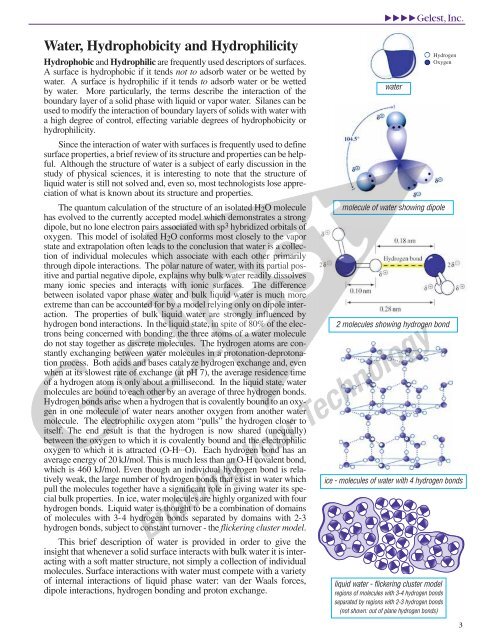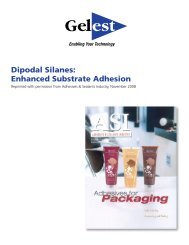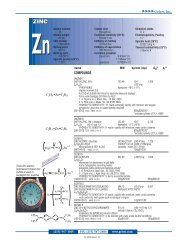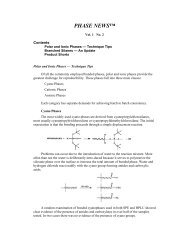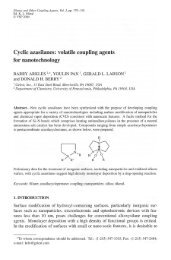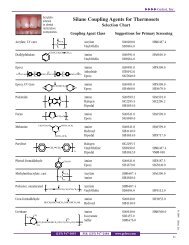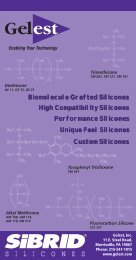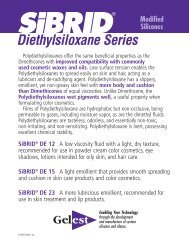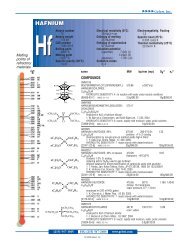Hydrophobicity - Gelest Inc.
Hydrophobicity - Gelest Inc.
Hydrophobicity - Gelest Inc.
Create successful ePaper yourself
Turn your PDF publications into a flip-book with our unique Google optimized e-Paper software.
<strong>Gelest</strong>, <strong>Inc</strong>.<br />
Water, <strong>Hydrophobicity</strong> and Hydrophilicity<br />
Hydrophobic and Hydrophilic are frequently used descriptors of surfaces.<br />
A surface is hydrophobic if it tends not to adsorb water or be wetted by<br />
water. A surface is hydrophilic if it tends to adsorb water or be wetted<br />
by water. More particularly, the terms describe the interaction of the<br />
boundary layer of a solid phase with liquid or vapor water. Silanes can be<br />
used to modify the interaction of boundary layers of solids with water with<br />
a high degree of control, effecting variable degrees of hydrophobicity or<br />
hydrophilicity.<br />
Since the interaction of water with surfaces is frequently used to define<br />
surface properties, a brief review of its structure and properties can be helpful.<br />
Although the structure of water is a subject of early discussion in the<br />
study of physical sciences, it is interesting to note that the structure of<br />
liquid water is still not solved and, even so, most technologists lose appreciation<br />
of what is known about its structure and properties.<br />
The quantum calculation of the structure of an isolated H 2 O molecule<br />
has evolved to the currently accepted model which demonstrates a strong<br />
dipole, but no lone electron pairs associated with sp3 hybridized orbitals of<br />
oxygen. This model of isolated H 2 O conforms most closely to the vapor<br />
state and extrapolation often leads to the conclusion that water is a collection<br />
of individual molecules which associate with each other primarily<br />
through dipole interactions. The polar nature of water, with its partial positive<br />
and partial negative dipole, explains why bulk water readily dissolves<br />
many ionic species and interacts with ionic surfaces. The difference<br />
between isolated vapor phase water and bulk liquid water is much more<br />
extreme than can be accounted for by a model relying only on dipole interaction.<br />
The properties of bulk liquid water are strongly influenced by<br />
hydrogen bond interactions. In the liquid state, in spite of 80% of the electrons<br />
being concerned with bonding, the three atoms of a water molecule<br />
do not stay together as discrete molecules. The hydrogen atoms are constantly<br />
exchanging between water molecules in a protonation-deprotonation<br />
process. Both acids and bases catalyze hydrogen exchange and, even<br />
when at its slowest rate of exchange (at pH 7), the average residence time<br />
of a hydrogen atom is only about a millisecond. In the liquid state, water<br />
molecules are bound to each other by an average of three hydrogen bonds.<br />
Hydrogen bonds arise when a hydrogen that is covalently bound to an oxygen<br />
in one molecule of water nears another oxygen from another water<br />
molecule. The electrophilic oxygen atom “pulls” the hydrogen closer to<br />
itself. The end result is that the hydrogen is now shared (unequally)<br />
between the oxygen to which it is covalently bound and the electrophilic<br />
oxygen to which it is attracted (O-H ... O). Each hydrogen bond has an<br />
average energy of 20 kJ/mol. This is much less than an O-H covalent bond,<br />
which is 460 kJ/mol. Even though an individual hydrogen bond is relatively<br />
weak, the large number of hydrogen bonds that exist in water which<br />
pull the molecules together have a significant role in giving water its special<br />
bulk properties. In ice, water molecules are highly organized with four<br />
hydrogen bonds. Liquid water is thought to be a combination of domains<br />
of molecules with 3-4 hydrogen bonds separated by domains with 2-3<br />
hydrogen bonds, subject to constant turnover - the flickering cluster model.<br />
This brief description of water is provided in order to give the<br />
insight that whenever a solid surface interacts with bulk water it is interacting<br />
with a soft matter structure, not simply a collection of individual<br />
molecules. Surface interactions with water must compete with a variety<br />
of internal interactions of liquid phase water: van der Waals forces,<br />
dipole interactions, hydrogen bonding and proton exchange.<br />
water<br />
Hydrogen<br />
Oxygen<br />
molecule of water showing dipole<br />
2 molecules showing hydrogen bond<br />
ice - molecules of water with 4 hydrogen bonds<br />
liquid water - flickering cluster model<br />
regions of molecules with 3-4 hydrogen bonds<br />
separated by regions with 2-3 hydrogen bonds<br />
(not shown: out of plane hydrogen bonds)<br />
3


